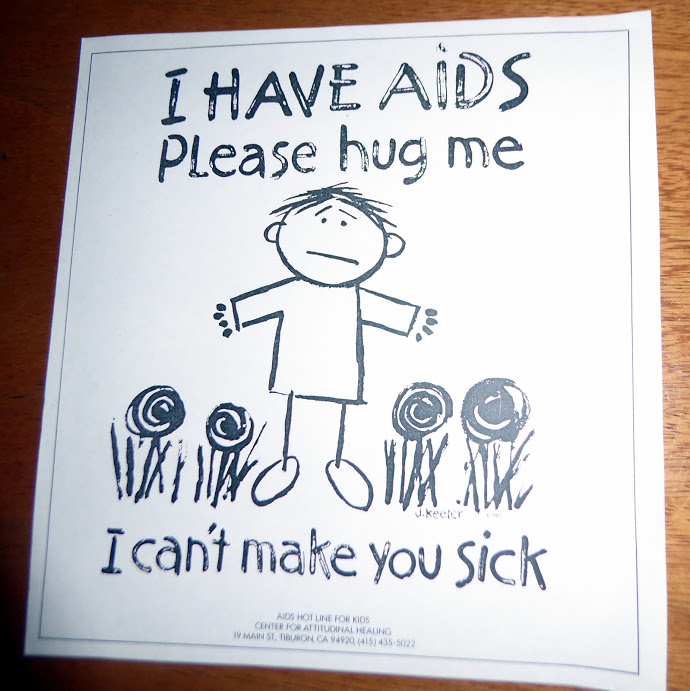
Blocks of from the AIDS Quilt from the Keweenaw Peninsula are seen. (Photo courtesy of the Marquette Regional History Center)
But by 1985 two people had died of AIDS here and soon public health directors, while trying to avoid panic, were warning that that yes, HIV had crossed the Mackinac Bridge and yes, it could affect men and women, children and adults, gay and straight.
The reaction in the U.P. mirrored what was going on elsewhere in the country. Fear that those “other people” — maybe prisoners or people at the airbase — might be bringing it into our community. A reluctance to allow comprehensive discussions of prevention strategies that might include mentioning the word “condoms” to teenagers.
There was also discrimination and hostility against those infected with HIV. Health care providers refused treatment, people lost jobs, churches turned their backs, and family members were ostracized. One woman reported that a plumber didn’t even want to fix her father’s toilet. Dr. Jeff Gephart, who was the U.P.’s only infectious disease specialist and director of the Marquette County Health Department AIDS Program, observed in 1992 that “the average AIDS patient has become a modern-day leper.”
But the U.P. made a remarkable turnaround — from hatred to compassion and care — as the result of the combined efforts of public health workers and advocates from the affected communities. It’s worth highlighting some of those efforts.

A poster asks for compassion for AIDS patients. (Photo courtesy of the Marquette Regional History Center)
The first was real coordinated care. By 1986 there was a testing and counseling program in Marquette and by 1989 there were support groups in Marquette and Houghton and “continuum of care” funds to provide outpatient services and support. People with HIV who returned to the U.P. from large urban areas with specialty clinics were pleasantly surprised to find that up-to-date care was being delivered in a very personalized manner. People who needed help with transportation, or drug treatment, or dental care got it and got it with a minimum of paperwork and hassle.
The second was the close partnership between people with HIV and public health. This was a big story nationally, but it was also an important one here. In Marquette, Marny Weting, a health department nurse who’d agreed to become the AIDS coordinator, was struggling to figure out how to reach out to the gay community when a couple, one of them HIV positive, walked into her office and asked how they could help.
In Dickinson County, Philip Hefner-Gardiepy, a longtime advocate who’d lost more than 100 friends to AIDS by the time he moved to Iron Mountain in 1992, showed up at the local health department asking how to volunteer and soon started the first support group in that part of the peninsula.
The third, flowing out of the new partnerships, was the decision to bring pieces of the AIDS quilt to the U.P. It was shown in Houghton, Kingsford, and in Marquette. Each time, panels of U.P. residents were included and more were added, including 14 new panels added when the quilt was in Houghton in 1995.
Bringing the quilt to the U.P personalized the epidemic in a way that nothing else could. Philip Hefner-Gardiepy described the time the quilt was in Kingsford as a “magical time.” Two co-workers visiting the quilt learned for the first time that they both had family members who’d died of HIV. A man who was born with HIV introduced a panel for his mother, who’d died when he was 4.
Hundreds of other visitors in all three cities saw names they recognized and the loving panels that had been made in their honor. It was a major change from the days when family members felt they had to write obituaries that concealed the real reason their loved one had died.
We do not yet have either a cure or a vaccine for HIV. But effective drug treatments, discovered in the mid-1990s, mean that most people with HIV are now living nearly normal lifespans. From a public health perspective, what’s at least equally important is that people on treatment are no longer infectious.
Prevention efforts that were once focused on safer sex practices are now mostly focused on testing efforts to identify people who may have the virus but don’t know it and making sure that people who do have the virus have access to care and treatment. And advocacy and education have made the U.P. a more welcoming place for those infected and impacted by HIV.